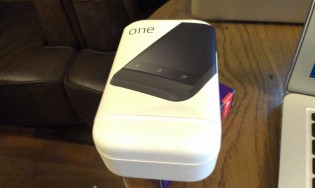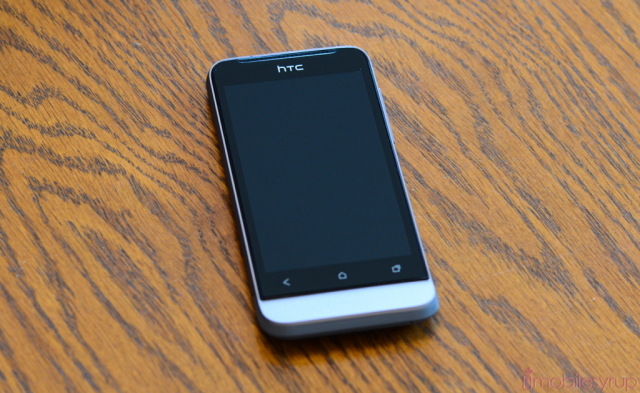
The HTC One V is the baby of the One Series, and certainly the least powerful of the three Android 4.0.3-powered smartphones. With a manageable 3.7-inch display, 1Ghz single-core processor, 512MB RAM and a 5MP camera, you’d be forgiven for mistaking the One V for the 2010 iPhone 4. But whereas the iPhone was a flagship device with a price tag of $650+, the One V harkens back to the HTC Legend in its design, and to the prepaid market in its $300 price.
HTC has not tried to hide its lineage, nor should it. The Legend was a handsome device for its time, but was hampered by a low-resolution screen and middling specs. Thankfully gone, too, is the Legend’s optical trackpad which betrayed Android’s non-touchscreen origins.
Bell has released the One V for free on a 3-year term and $300 outright, prices that, along with the user-friendly Sense 4.0 interface, will likely attract many customers. But is the Legend successor worth your money? How does it compare to the similarly-priced Lumia 710 from Rogers or competing Androids like the Samsung Galaxy W? Read on to find out.
Specs:
– Android 4.0.3 with Sense 4.0
– 3.7-inch 480 x 800 LCD display
– 1Ghz Snapdragon MSM8255 single-core processor w/ Adreno 205 GPU
– 512MB RAM / 4GB internal storage (1GB for apps, 95MB SD card)
– 5MP camera with LED flash
– 720p video capture
– WiFi (b/g/n), Bluetooth 4.0, A-GPS
– 120.3 x 59.7 x 9.2 mm
– 115g
– HSDPA 14.4Mbps, HSUPA 5.76Mbps
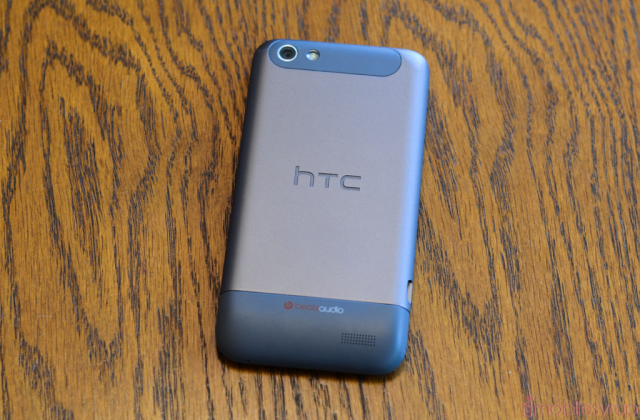
Design & Display
What’s so interesting about the HTC One V is its immediate familiarity. Created out of a single piece of aluminum, its resemblance to the Legend is more than just homage: the phone is a veritable sequel. From the distinctive chin to removable plastic piece for the SIM card, the One V is that rare 2.0 that improves upon almost every aspect of the original.
Whereas the Legend was a chubby 11.5mm, the One V is a manageable 9.2mm thick. The Legend has a trackpad and low-resolution screen; the One V has a larger WVGA display and has been adapted for Android 4.0. The One V has its volume rocker on the right side and its camera sensor off-centre, but you’d be forgiven for missing those small details. The Legend 2 is a great-looking smartphone.
Compared to the massive One X and the tall-but-thin One S, the One V is mostly usable with one hand. The 3.7-inch LCD display is vibrant and clear, and with a 252ppi pixel density doesn’t match the One X in clarity but manages to outdo most displays in its price range. Viewing angles are fantastic; maximum brightness is more than adequate; blacks reasonably deep.
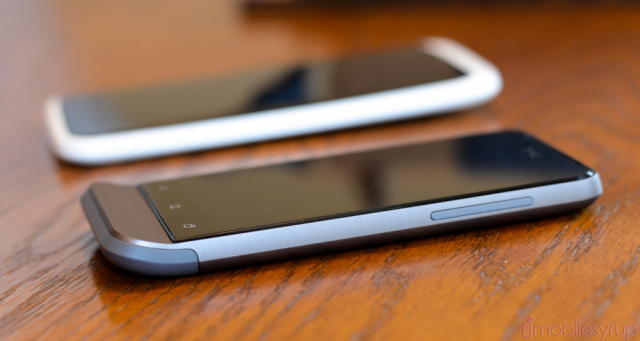
Recall that WVGA was the de facto Android resolution until well into 2011. The Nexus S, that standards-setting Google phone, shared the same resolution, as did HTC’s Incredible S and Desire HD. Those devices, however, had comparatively larger screens and much higher price tags. The One V is a testament to how quickly once-expensive components can drop in price.
Compared to the Galaxy W or even the Lumia 710, the One V feels the best-made of the bunch. There isn’t a creak or loose seam to be found, and the compactness of the phone only furthers its robustness. Like the Legend, the only real place for improvement in the body is the the detachable SIM/microSD cover, which feels tacked on and ready to snap at any moment. Rest assured, though, even after dropping the phone numerous times the clips stayed put.
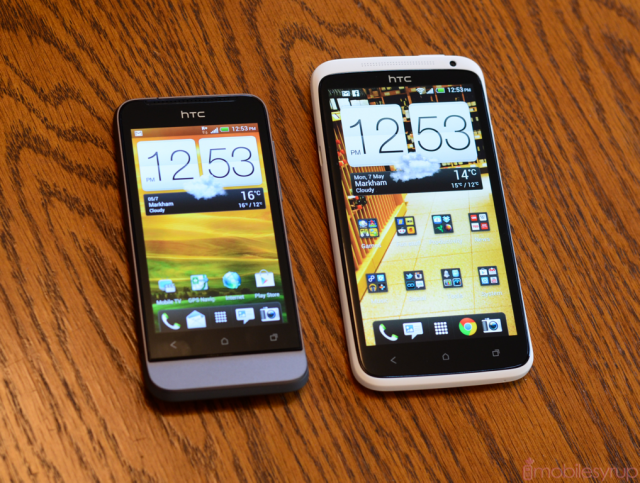
Performance
For a $300 phone, the One V has objective performance comparable to the HTC Incredible S, which was one of my favourite devices of 2011. It has the exact same single-core 1Ghz processor and GPU which, architecturally are two generations old, but don’t tell that to Sense 4.0. Considering that the One V is debuting only a year after the Incredible S, with similar specs at half the price, there’s no reason to doubt the phone’s performance.
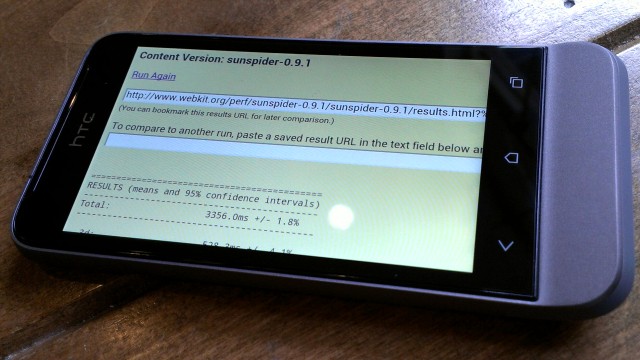
Subjectively, the One V performs extremely well. With HTC’s pared-backed Sense 4.0 overlay and myriad hardware acceleration optimizations, there isn’t a lot to complain about. Everything I threw at it, from games to Javascript-heavy browsing, was reasonably stutter-free. Sure, the processor hits a wall at HD video and the latest and greatest 3D games, but that’s about all it won’t do. In terms of benchmarks, the One V is between one-third and half as fast as modern dual- and quad-core devices. This is understandable based on the single-core Snapdragon processor, but that processing power deficit rarely translates into regular usage. Android 4.0 finally brings Android into consistent smoothness territory, and the One V proves that applies to relatively older hardware, too.
For the average user looking for a mid-range smartphone the One V is very competitive.
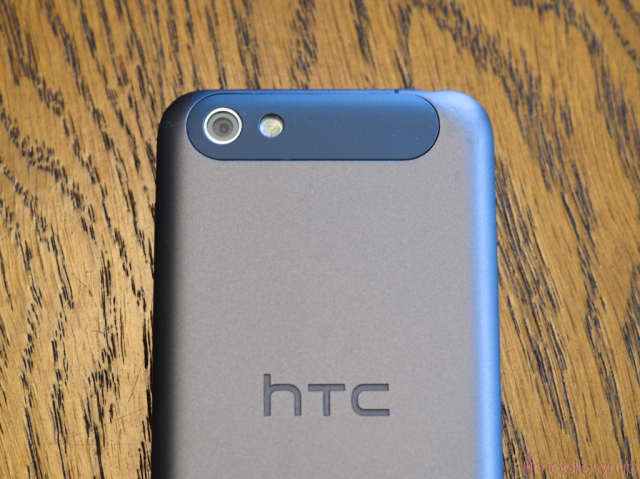
Camera
The One V has the same camera architecture as its bigger brothers, and while the sensor itself is not the same — a smaller, grainier 5MP part compared to the spacious and sharp 8MP on the One S/X — performance is quite similar. But for the ability to shoot 1080p video — the One V maxes at 720p for processor reasons — the experience is identical. The One V boasts the same lockscreen shortcut and instant shutter, and while it doesn’t match the 4fps continuous shutter and sub one-second startup time, the differences were so minute as to be negligible.
The same thorough camera options are there too: exposure, contrast, saturation, sharpness; face detect; auto white balance and ISO; smile capture; auto upload to Facebook or Flickr. You can take 3MP photos while shooting 720p video, a step down from the 5MP shots and 1080p video of the One S/X, but the experience is similarly positive. Basic editing features such as rotation and cropping are included in the redesigned photo review tool and, of course, you can share your photos to any supported Android app.
Where the One V suffers, however, is where it’s most important not to: photo quality. There is nothing wrong with photos captured by the One V, but they lack the clarity and punch of their more expensive contemporaries. Compared to devices in a similar price range the One V competes quite well, offering a compelling experience for both still, landscape and macro photos despite its hardware limitations. But reasonably “easy” scenes such as a well-lit room are often blown out; the One V often overexposes or washes out colours. In darker areas grain and noise expose the sensor’s inexpensive origins; despite a f/2.0 aperture the quality of low-light photos is significantly worse than the One X.
Like the One X, the One V had trouble with macro autofocus, such as the above yellow tulips. It took a few tries tapping on the screen to get the focus to “take” but eventually it worked. Generally, though, the autofocus worked extremely well; this is an area that HTC has improved on immensely since the Incredible S.
It must be said that the One V is missing a front-facing camera, something that many inexpensive smartphones are beginning to offer. While unlikely to be a blow to most consumers it’s something to consider if you are an avid Skype or Google Talk video user.
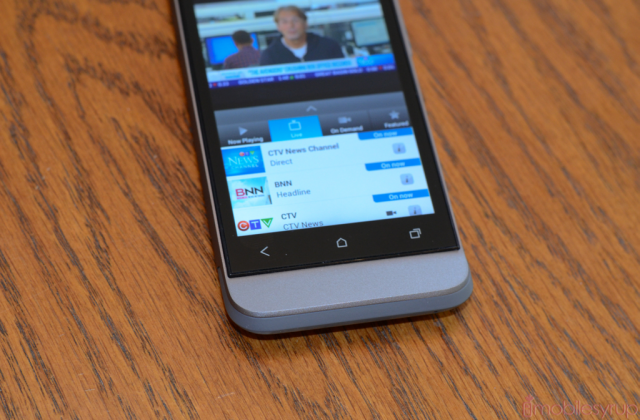
Software
It cannot be overstated how important it is that the One V comes pre-installed with Android 4.0. This is the first sub-$500 device in Canada to ship with Ice Cream Sandwich (if you don’t count the $430 Galaxy Nexus from Expansys, that is), and the performance benefits are largely a result of native hardware acceleration.
The One V runs the same Sense 4.0 build as the One X with a few minor adjustments. For starters, the lack of screen real estate precludes a virtual menu button, so instead of bringing back a hardware version it is activated by holding down on the multitasking button for a second. While this keeps the capacitive button layout consistent throughout the One series, it feels forced; I generally press the menu button five times for every one multitasking.
Perhaps due to the lack of GPU speed, HTC has chosen to retain the original vertically-aligned multitasking menu from stock Android 4.0. This should have been the case with more powerful One devices, too, as it manages to perform faster and more intuitively than the poorly-designed carousel included in the more powerful One S and One X.
For a more in-depth look at HTC’s Sense 4.0 overlay, take a look at our One X review. But in a nutshell, the software is mercifully free of excess, and is a vast improvement over previous iterations. Sense UI may be even more acceptable on the One V than the One X due to the typical low- to mid-range Android phone user being less of a power user and less likely to replace the stock social media and weather widgets. Sense 4.0 offers plenty of interactions with services besides Google: Skydrive, Dropbox, Facebook, Twitter, Exchange are all present, and work well through HTC’s stock apps. Curiously, though HTC provides its own Facebook/Twitter app called Friendstream, the official apps are also included.
Bell has included its excellent Mobile TV app with the One V, and it works as expected over the carrier’s HSPA+ network. Since One V only supports connections up to 14.4Mbps down, videos tend to buffer for longer than average, but once loaded the video is smooth and sharp.
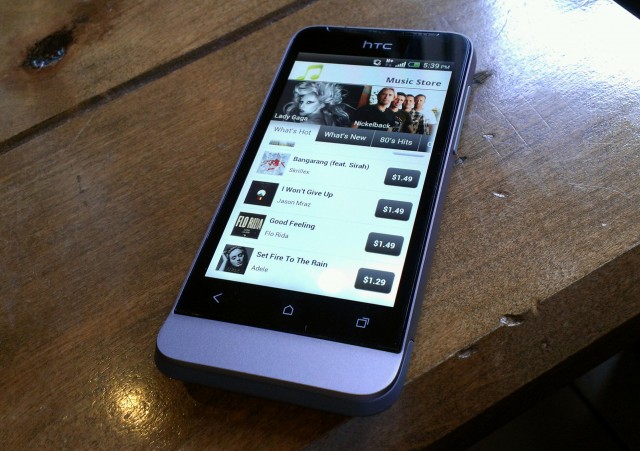
Bell seems to have chosen the One V to debut its Music Store app. It doesn’t seem to have any relation to previous Bell music apps such as InMusic MP3 Store, and is available as a separate download from Google Play. Songs cost between $0.99 and $1.49, with albums going for around $10.99 on average. The interface is slick and clean, and it appears the songs are DRM-free. The service is offered by Livewire Mobile, a white-label MP3 provider for “40 mobile operators, Livewire Mobile reaches over 400 million mobile consumers worldwide with our suite of mobile content services including music, ringbacks, games, applications, video and more to transform everyday mobile communication into a fun, exciting and personal experience.” According to the website, Livewire powers music stores for “Sprint, Bell Mobility, Virgin Mobile Canada, 3UK, 3 Ireland and Telecom New Zealand.”
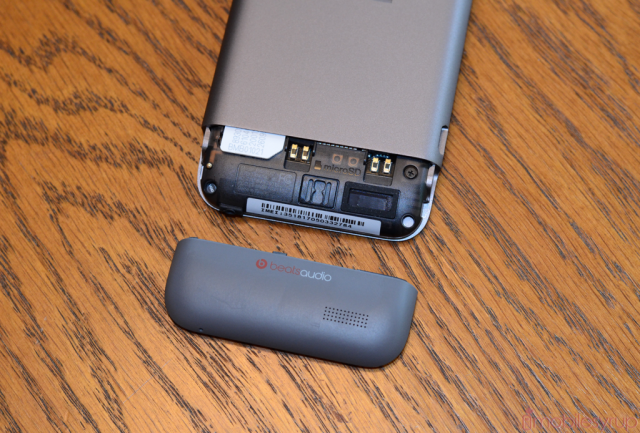
Network Speed, Storage & Sound Quality
First, the bad news. The HTC One V doesn’t come with a microSD card. At least the Bell demo unit provided to me didn’t. That means that out of the box there is less than 100MB to work with, which is enough for the odd photo but precludes taking screenshots or storing any external media. You’ll want to spend the $35 for a 32GB microSD card, or $15 for a 16GB card at the very least (not endorsing any product or retailer, just using NCIX and Patriot/A-Data as examples).
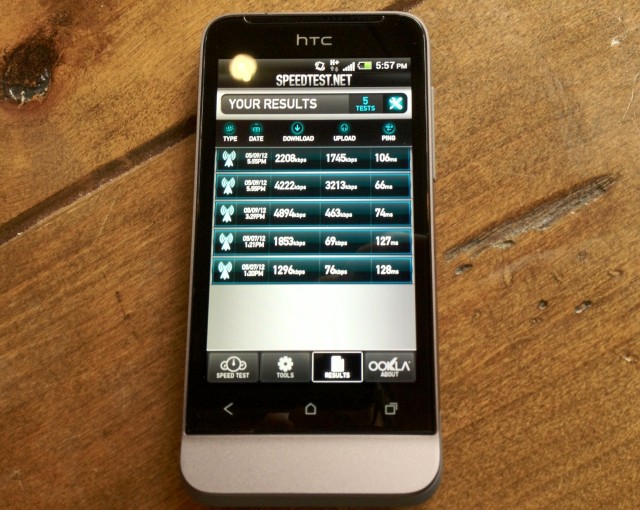
The One V is noticeably slower than the LTE-capable One X, or any latest-generation HSPA+ device for that matter. Results between 2Mbps and 4Mbps down and just 150kbps were normal. Thankfully, Bell’s HSPA+ ping times have always been low and the One V is no exception.
Call quality on the One V was good-to-excellent depending on the recipient. The headpiece is quite wide (and distinctive) and sound was very clear, often more so than the Rogers One X. As expected, the mono back speaker is only good for conference calls in quiet rooms — music sounds tinny and shrill, with a lack of low-end bass.
One of HTC’s better Sense customizations was the ability to activate the speakerphone while on a call by placing the phone face down on a surface. The proximity sensor and accelerometer together detect the distinctive motion and enable the speaker. When you pick up the phone again and place it to your ear, the call goes back to the headpiece.
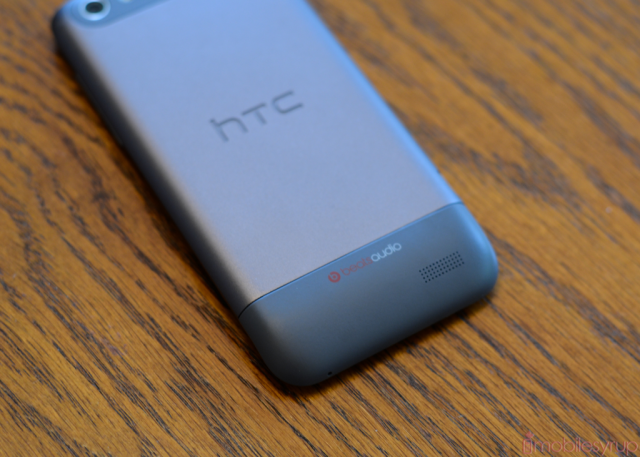
Beats Audio is another feature that will likely get people in the door, but it only works properly if you already have a pair of Beats headphones. As I said with the One X, despite the fact that the Beats platform is enabled on any headphones, the equalizer has been custom-made for Beats Solo over-ear cans and Beats Tour in-ear phones. Typically, when Beats is enabled the song gets louder and bass gets deeper. In other words, the soundstage is narrowed and the dynamic range compression is increased. This sounds great when listening to bass-heavy techno and dubstep, but anything with lyrics sounds muffled and messy.

Battery Life
It wasn’t too long ago that a 1500mAh battery was considered spacious in the Android community. Oh, how times have changed.
The One V is a workhorse. Due to the relatively low-power single-core processor, I was able to get between 15 and 24 hours on a regular basis doing all the things one would normally do on a smartphone: make calls, send texts, answer emails, check Twitter and Facebook, take photos, do a bit of browsing and gaming. The overall performance doesn’t match the latest and greatest smartphones on the market, but the One V could have performed well and lasted four hours. It doesn’t.
It also has insane standby time: during my testing, I kept the One V on and receiving various emails and Twitter messages, but otherwise stayed away from it. As you can see above, after nearly three days the battery still had 32% left.
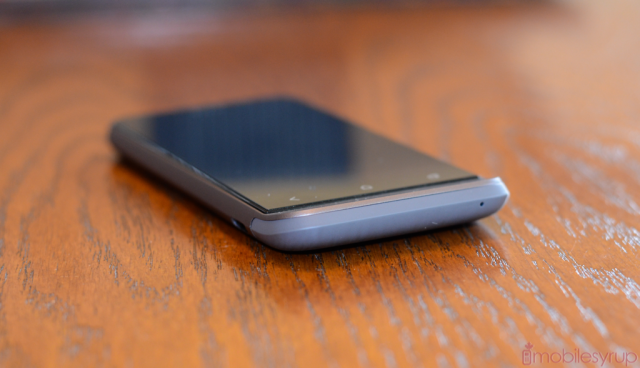
Conclusion
The One V is neither the best phone on the market, nor the best One Series device. But it isn’t trying to be: the device fits into a very important niche within the low-cost smartphone category, and at the moment there isn’t a better proposition. At $300 outright and $0 on a 3-year term (TELUS will likely sell it for $29.99 on a 3-year term when it debuts on the 17th) the One V is a great deal. Yes, it has last year’s internals and requires a microSD to work properly, but at this point the One V is the only low-cost Android phone I can recommend to most people.
If you’re having a tough time deciding between the One V and the Lumia 710, it’s a matter of operating system as they both have similar specs. Many users will prefer the smooth and intuitive Windows Phone interface but will disparage the lack of apps (though more are coming). If your choice is between the One V and a similarly-priced Android like the Samsung Galaxy W, take the one with Android 4.0 every time; you never know whether the Galaxy W will be updated to Ice Cream Sandwich.
More to the point, the One V is a compelling phone regardless of price. It is robustly made, performs well, has a decent camera, excellent battery life and great call quality. For $300, what more can you ask for?
Find out more about the HTC One V at Bell.
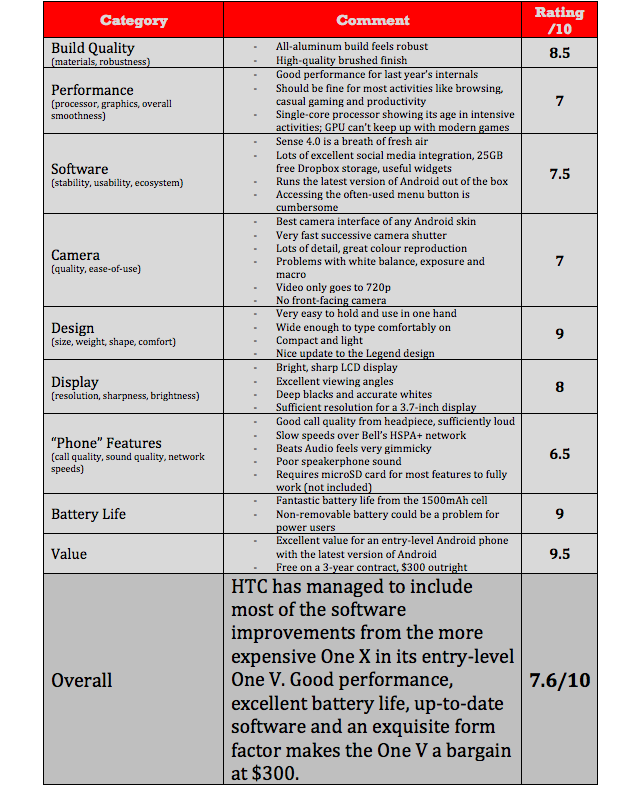
MobileSyrup may earn a commission from purchases made via our links, which helps fund the journalism we provide free on our website. These links do not influence our editorial content. Support us here.


